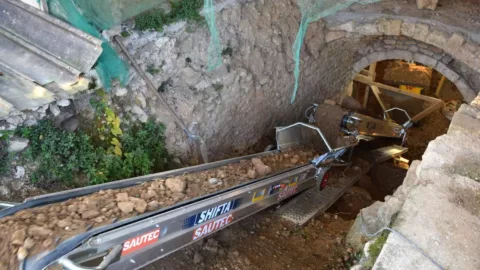Bulk loading of containers: several solutions to meet the needs of exporters.

The export of goods in bulk is a practice that is making a strong comeback. To meet the new needs of exporting companies, we have developed and designed several bulk container loading solutions.
Traditionally, goods such as cocoa beans or coffee beans are transported and exported in jute bags weighing around 65kg. In recent years, bulk transport, which is more appropriate for supplying processing units, has become increasingly popular. While export in bags was accessible to all operators, the carrying out of bulk loading operations requires adapted equipment. In order to help a large number of exporting companies adapt to new shipping methods, whatever the technical means at their disposal, we have developed and designed several mobile and flexible stuffing installations for 20 and 40 foot containers. In this way, loading operations can be carried out regardless of the position of the container: in an inclined or horizontal position on a trailer or simply placed on the ground.
An optimised and secure cutting bag area.

Unloading hopper equipped with a platform for depositing the pallets and cutting the bags.
The common element between the different installations we offer is the loading conveyor. Composed of an unloading hopper and a platform for depositing pallets, this belt conveyor allows operators to benefit from an optimised and secure bag cutting area allowing 3 “cutters” to work together. As for the platform, it can receive up to 5 pallets, approximately 40 bags of 65 kg. The loading conveyor offers many advantages: respect of the product quality, performance (loading capacity between 100 and 120 t/h) and safety.
Belt conveyor, mobile loading conveyor or telescopic conveyor?
In addition to optimising the cutting of the bags, the conveyor makes it possible to feed a second equipment which differs according to the stuffing method used by the exporters.
If the container is inclined on a hydraulic trailer (figure 1), the belt conveyor will allow the bulk goods to be picked up at the exit of the conveyor and thus convey the products to the entrance of the container. We systematically equip the mobile belt conveyor with an orientable chute with a flexible sleeve in order to preserve the quality of the product and of course to optimise the filling and distribution of the goods.
If the container is in a horizontal position on a non-hydraulic trailer (figure 2), the system is composed of a loading conveyor. This equipment has the distinctive characteristic of having one part inclined vertically to raise the product, and another horizontal one to carry out the loading. The loading conveyor is equipped with swivel wheels for revolving (left/right) and an adjustable tilting system of the front part to allow the good distribution of the product in the container. Contrary to the elevating conveyor belt, it is the truck which, when moving forward, allows the container to be filled gradually. Depending on the characteristics of the site (presence or not of a shipping dock for example), several lengths are available.
If the container is placed on the ground (figure 3), we recommend the telescopic loading conveyor to our customers. The sweeping of the telescopic conveyor makes it possible to place several containers side by side. Container loading operations are not interrupted while the other containers are being placed.
Finally, since the end of 2020, we have been offering a container tipper that allows 20 and 40-foot containers to be tilted at an angle of 40°.
More than a marketing argument, the advantageous characteristics of our equipment meet real local needs.
Offering several types of stuffing installations to our customers enables us to give them the means to adapt to new market requirements. Our aim is to provide our customers with more efficient and safer working methods, enabling them to be more competitive and to access economic opportunities at a low investment cost. The stuffing plants we have designed are robust, easy to maintain and easy to use. Their high mobility allows them to be easily moved or transported from site to site. Among the projects we have carried out, we have, for example, the case of a customer who, thanks to our equipment, has been able to develop its stuffing activity directly at its customers’ sites, or a major operator in the transport and logistics sector who wanted to benefit from a mobile potting station to complement its fixed stations.
It is with this desire to support our customers in their projects that we created our subsidiary SAUTEC Ivory Coast at the beginning of February 2021. This new entity will enable us to provide new services: audit, parts supply and maintenance of all brands of belt conveyors and belt conveyor rental. This new structure will also spread out in neighboring and nearby countries: Mali, Burkina Faso, Ghana and Togo.


























